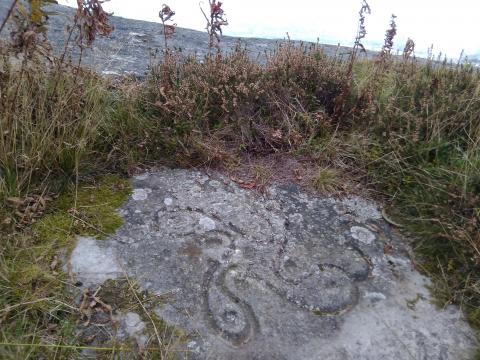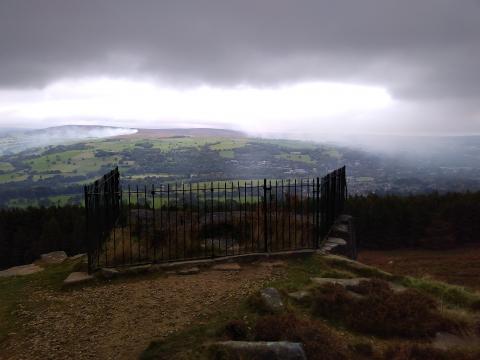Swastika Stone

Another must-see of Ilkley Moor, along with the badger and idol stones, is the swastika stone. The word swastika fills my heart with dread and opprobrium, a version of it having been adopted by Germany’s inter-war national socialists. It stands for the evil of racial hatred and serves as a reminder of what happens to European societies when they sever their Judaeo-Christian roots.
This stone’s swastika is rather pleasanter than that employed by Nazis old and neo. For a start, it dates to anywhere between 500 and 2000 years before Christ was born, and it was given its name back in 1880, 9 years before Hitler was born. Furthermore, the design is rather more fluid and freer than the 1930’s rather rigid version, with its stark right angles. Here is a series of cupmarks using a north-south alignment, and then four loops carved around them, with a peculiar ‘tail’ to the right-hand side. The interpretations of this are as varied and numerous as there are interpreters. Buddhists see their ideas contained in the carvings, others see an ancient creation myth, others the source of life. The always well informed Paul Bennet, for The Northern Antiquarian, points out
The eastern axis points directly at Almscliffe Crag, above which the equinox sun seems to rise from here.
I came across swastikas in ancient Christian catacombs in Rome. There they were said to represent the rising sun, and therefore a fitting symbol for Christ, the Light of the world, whose rising from the dead illuminates all who believe.
We may speculate about the Ilkley stone until the cows come home; we shall never know its original purpose or rationale, nor the identity of those who made it. We who hold the Biblical record to be true might consider those boulders to have known Noah's immediate descendants, fulfilling His command to cover the earth. Perhaps the carving is a pictoral commemoration of God’s promise to maintain the cycle of summer and winter, springtime and harvest. These seasons were designed by God for the post-diluvian world which these men and women inhabited, which may be indicated by the tail. I suppose my speculation is as unhelpful as any others'. We may be sure, however, that it had nothing to do with the racial hatred its more angular cousin was associated with some millenia later on.
Or, might it just be a wonderful piece of art deposited on a beautiful piece of northland moor?

- Log in to post comments


 Sunday Worship 10.45am & 6.00pm
Sunday Worship 10.45am & 6.00pm